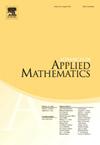Primary decomposition theorem and generalized spectral characterization of graphs
IF 1.3
3区 数学
Q3 MATHEMATICS, APPLIED
引用次数: 0
Abstract
Suppose G is a controllable graph of order n with adjacency matrix A. Let (e is the all-ones vector) and ('s are eigenvalues of A) be the walk matrix and the discriminant of G, respectively. Wang and Yu (arXiv:1608.01144) [21] showed that if is odd and squarefree, then G is determined by its generalized spectrum (DGS). Using the primary decomposition theorem, we obtain a new criterion for a graph G to be DGS without the squarefreeness assumption on . Examples are further given to illustrate the effectiveness of the proposed criterion, compared with the two existing methods to deal with the difficulty of non-squarefreeness.
图的初等分解定理与广义谱表征
设G是一个具有邻接矩阵a的n阶可控图,设W=[e,Ae,…,An−1e] (e为全一向量),Δ=∏i>j(αi−αj)2 (αi为a的特征值)分别为G的游走矩阵和判别式。Wang和Yu (arXiv:1608.01144)[21]证明了如果θ(G):=gcd(2−⌊n2⌋det (W),Δ}是奇数且无平方的,则G由其广义谱(DGS)决定。利用初等分解定理,得到了图G为DGS的一个新的判据,该判据不需要在θ(G)上的平方性假设。通过与现有的两种处理非平方性困难的方法进行比较,进一步说明了该准则的有效性。
本文章由计算机程序翻译,如有差异,请以英文原文为准。
求助全文
约1分钟内获得全文
求助全文
来源期刊

Advances in Applied Mathematics
数学-应用数学
CiteScore
2.00
自引率
9.10%
发文量
88
审稿时长
85 days
期刊介绍:
Interdisciplinary in its coverage, Advances in Applied Mathematics is dedicated to the publication of original and survey articles on rigorous methods and results in applied mathematics. The journal features articles on discrete mathematics, discrete probability theory, theoretical statistics, mathematical biology and bioinformatics, applied commutative algebra and algebraic geometry, convexity theory, experimental mathematics, theoretical computer science, and other areas.
Emphasizing papers that represent a substantial mathematical advance in their field, the journal is an excellent source of current information for mathematicians, computer scientists, applied mathematicians, physicists, statisticians, and biologists. Over the past ten years, Advances in Applied Mathematics has published research papers written by many of the foremost mathematicians of our time.
 求助内容:
求助内容: 应助结果提醒方式:
应助结果提醒方式:


